Body-stalk
The body-stalk, also known as the allantoic stalk,[1] is a band of mesoderm that connects the caudal end of the embryo to the chorion in development. With the formation of the caudal fold, the body-stalk assumes a ventral position; a diverticulum of the yolk-sac extends into the tail fold and is termed the hindgut. With continued development, the body-stalk is later replaced by the umbilical cord.
| Body-stalk | |
|---|---|
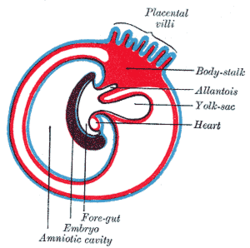 Diagram showing the expansion of amnion and delimitation of the umbilical cord | |
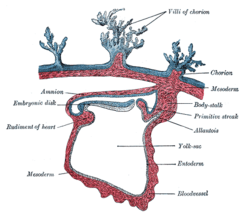 Section through the embryo | |
| Details | |
| Identifiers | |
| Latin | Pedunculus truncalis |
| Anatomical terminology | |
Body stalk anomalies occur in approximately 1 in 15,000 births.[2] They are due to defects in the formation of cephalic, caudal, and lateral embryonic body folds,[3] that result in a reduced or absent umbilical cord.[4]
Additional images
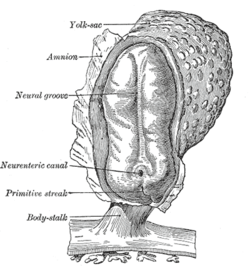 Human embryo—length, 2 mm. Dorsal view, with the amnion laid open. X 30.
Human embryo—length, 2 mm. Dorsal view, with the amnion laid open. X 30.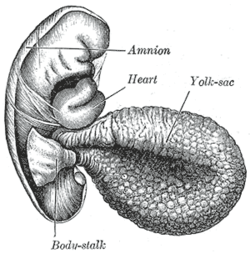 Human embryo of 2.6 mm.
Human embryo of 2.6 mm.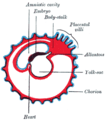 Diagram showing later stage of allantoic development with commencing constriction of the yolk-sac.
Diagram showing later stage of allantoic development with commencing constriction of the yolk-sac.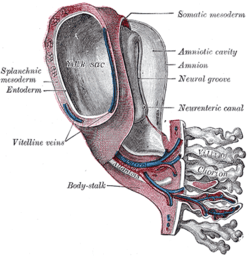 Model of human embryo 1.3 mm. long.
Model of human embryo 1.3 mm. long.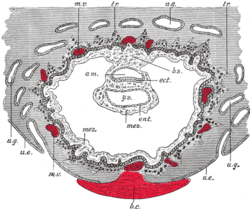 Section through ovum imbedded in the uterine decidua.
Section through ovum imbedded in the uterine decidua.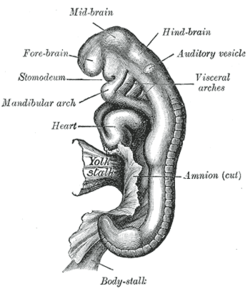 Embryo between eighteen and twenty-one days.
Embryo between eighteen and twenty-one days. Human embryo about fifteen days old. Brain and heart represented from right side. Digestive tube and yolk sac in median section.
Human embryo about fifteen days old. Brain and heart represented from right side. Digestive tube and yolk sac in median section.
References
- Arthur Robinson (1913). Cunningham's Textbook of Anatomy. William Wood. p. 54.
- Asim Kurjak (30 June 2013). Donald School Textbook of Transvaginal Sonography. JP Medical Ltd. p. 28. ISBN 978-93-5090-473-2.
- Diana W. Bianchi; Timothy M. Crombleholme; Mary E. D'Alton (1 January 2000). Fetology: Diagnosis & Management of the Fetal Patient. McGraw Hill Professional. ISBN 978-0-8385-2570-8.
- Kocherla, K; Kumari, V; Kocherla, PR (January 2015). "Prenatal diagnosis of body stalk complex: A rare entity and review of literature". The Indian Journal of Radiology & Imaging. 25 (1): 67–70. doi:10.4103/0971-3026.150162. PMC 4329692. PMID 25709170.
This article is issued from
Wikipedia.
The text is licensed under Creative
Commons - Attribution - Sharealike.
Additional terms may apply for the media files.